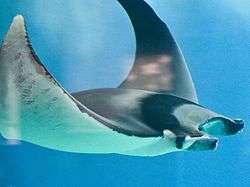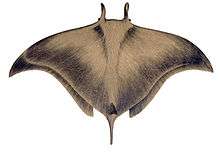Devil fish
| Devil fish | |
|---|---|
 | |
| Scientific classification | |
| Kingdom: | Animalia |
| Phylum: | Chordata |
| Class: | Elasmobranchii |
| Order: | Myliobatiformes |
| Family: | Myliobatidae |
| Genus: | Mobula |
| Species: | M. mobular |
| Binomial name | |
| Mobula mobular (Bonnaterre, 1788) | |
| Synonyms | |
| |
The devil fish or giant devil ray (Mobula mobular) is an endangered species of eagle ray in the family Myliobatidae. It is currently listed as endangered, mostly due to bycatch mortality in unrelated fisheries.
Description
The devil fish is larger than its close relative the lesser devil ray. It grows to a maximum recorded length of 5.2 metres (17 ft), making it one of the largest rays. It possesses a spiny tail.[2]
Distribution and habitat

Devil fish are most common in the Mediterranean Sea and can be found elsewhere in the Eastern Atlantic Ocean, off the southwest coast of Ireland and south of Portugal, and possibly in the northwest Atlantic. They predominantly prefer deep waters.[2]
Devil fish inhabit offshore areas to the neritic zone, their range as deep as several thousand meters. They are typically observed in small clusters, and may occasionally form larger groups.[1]
Ecology
Devil rays feed on planktonic crustaceans and small schooling fish, which are trapped using the modified gill covers (branchial plates) responsible for its "devil-like" silhouette. The species is ovoviviparous: the young hatch from their eggs inside the mother's body and emerge later when they are more fully grown. Only a single live young which is called a pup is born at a time.[1]
Conservation status
The devil fish has a limited range and a low rate of reproduction. As a result it is sensitive to environmental changes. The main threats to this species come from pollution in the Mediterranean and bycatch capture in various fishing equipment including trawls, tuna traps, and dragnets meant for swordfish. The 2004 IUCN Red List listed the devil fish as a vulnerable species. It was reclassified as endangered in 2006 due to low population resilience coupled with continued high bycatch mortality.[1]
References
- 1 2 3 4 Notarbartolo di Sciara, G.; Serena, F. & Mancusi, C. (2006). "Mobula mobular". IUCN Red List of Threatened Species. Version 2014.3. International Union for Conservation of Nature. Retrieved 3 May 2015.
- 1 2 Froese, Rainer and Pauly, Daniel, eds. (2015). "Mobula mobular" in FishBase. 4 2015 version.
| Wikimedia Commons has media related to Mobula mobular. |
